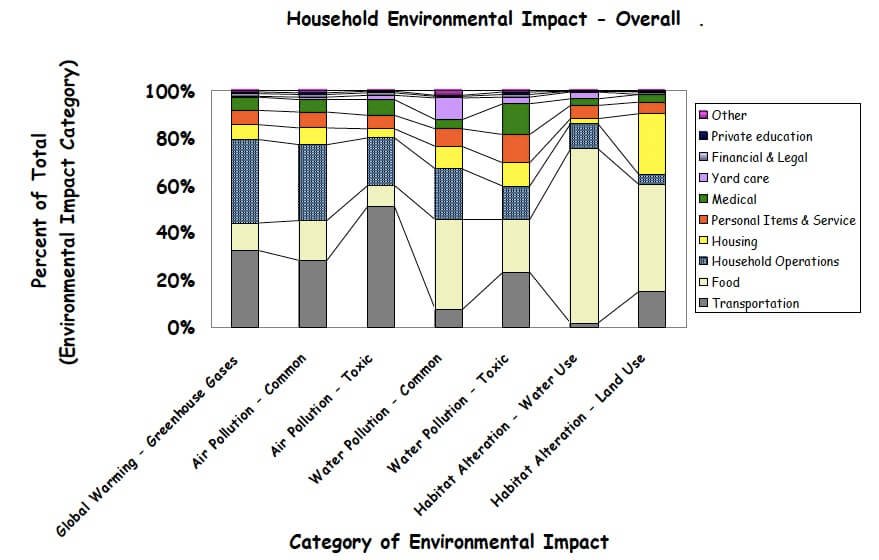We are hearing more and more about “being green” every day in the news. But what does “being green” really mean to the typical American household? We’re flooded with green product marketing every day, but which of these products will make the most difference, and (since we’re all on a budget) for the least cost?
To begin to answer these questions, we must first identify our household activities and the extent to which they contribute to our environmental impacts. Refer to the chart “Household Environmental Impact – Overall”. This chart shows, for a typical American household, both the category of environmental impact and the family activities that comprise each category.
After reviewing this chart, we will better understand the activities that have the most, as well as the least, environmental impact. That will, in turn, give us a better idea of how to prioritize the changes we can make to get ourselves on track to “being green!”

Household Environmental Impact – Overall
The first thing you’ll notice is that environmental impact is divided into seven different categories. Let’s begin by focusing on the first category, global warming greenhouse gasses.
The legend on the right of the chart shows the household activities that make up our environmental impact in this category. Note that the greenhouse gas category, like the other impact categories, begins with transportation. Moving up the greenhouse gas type “bar,” the next activity is food, followed by household operations, then housing, etc.
Approximately 80% of our household’s contribution to global warming greenhouse gasses comes from three family activities. “Household operations,” which is mostly utilities (gas and electricity) is the largest followed by transportation and food.
If we look at the other categories of environmental impact, we’ll see a similar trend. The “big three” household activities – transportation, food and household operations (utilities) – contribute the majority of our environmental impact! Let’s focus, for the duration of this relatively short article (given the size of the issues involved) on the “big three.”
Transportation is probably one of the easiest, most cost-effective changes we can make in our quest to go green. The simplest, most immediate solution is to spend a few minutes every day thinking about how we can minimize the miles we drive. It might sound trite to some people, but I always surprise myself at the time (and energy and reduced environmental impact) that results from a small investment of “planning time” every day. I’ve found that the few minutes of time I invest in planning my driving “pays back” many times over. Time is the most precious commodity I have, at least until someone discovers the path to immortality, so from a time-savings standpoint alone I’m getting a high “return on my investment” – the fact that I’m reducing my energy and environmental impacts is the icing on the cake!
Then there’s the type of vehicle we choose to drive. Do we really “need” truck, van or SUV? Just 20 years ago only 15% of new car purchases were in this category whereas today it’s around 50%!
Whether it is safety, utility, or nearly any other factor related to “need,” there’s a more efficient alternative than what I see most people I know driving. Hybrids (like the Toyota Prius) are a great solution for people that drive more than average or those that want to invest in the most environmentally sustainable vehicle possible. For people that can’t afford a hybrid, there are high-mileage alternatives (such as the Toyota Yaris). The internet has a wide variety of websites to help consumers navigate the options available to find a balance between cost, safety, and environmental stewardship.
The “food category” is also easy to address. In general, eating lower on the food chain by eating more fruits and vegetable and less meat reduces environmental impact. Likewise, locally produced, organically grown food also reduces environmental impact. Our local markets are carrying more such foods every day, making it easier to eat green! Lastly, the “utilities” category is typically a very cost-effective area to make changes. Past articles in this publication have addressed ways households can reduce energy use in economically viable ways, and future articles will touch on these subjects in more detail. There’s a lot to say about this topic but, in general, making a home more energy efficient is the most cost-effective place to start. Replace old heating, cooling, and water heating equipment with more efficient equipment when the time comes.
Replace incandescent bulbs with compact fluorescents when the old bulbs burn out. Add insulation if your insulation is less than recommended for your climate, and replace old single pane windows with dual pane low-e glass. After you’ve eliminated waste, the next most cost-effective step is usually solar water heating, followed by solar power (assuming you have the sun, of course)!
I have to admit that, in the short space provided, this has been a very “quick and dirty” treatise on green living. It’s a huge subject with thousands of different answers (and similar details) that depend on the specific household in question. But at least we have, hopefully, developed a better general feel for those household activities that have an environmental impact and the solutions needed to become more green! We’ll be covering this subject in a lot more detail in the future.
